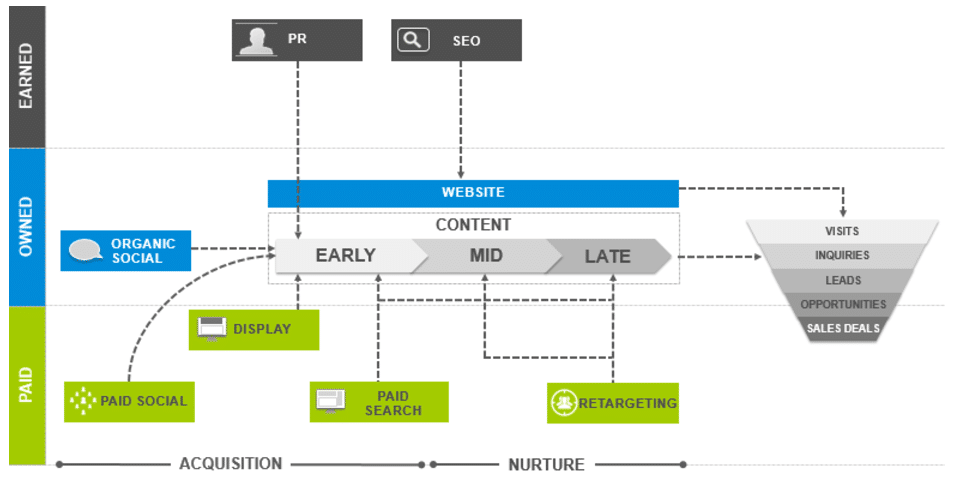The current digital marketplace is filled with fragmented, mixed messages, which is why it’s so important to unify your user experience throughout the sales funnel. To do so, you must first map your business’ sales cycle. The sales cycle is essentially the journey each buyer takes from origin of issue to conversion or purchase and, in many cases, beyond.
In this post, we’ll showcase how to leverage channel tactics to tailor your message and timing based on where the user is in the cycle. Learn how to adapt your integrated marketing approach to correspond with the unique length of your sales cycle, thus increasing the likelihood of reaching your business goals, while staying within your budget.
Stages of the sales cycle
Many industries are known for their long sales cycles, such as automotive, software, real estate, insurance, finance and much of the B2B space. What does a sales cycle actually look like? The following stages are common to most industries:
-
- Prospecting for leads: Identifying potential customers.
-
- Setting an appointment: Reaching out to prospects (via cold calling, email, social media, snail mail or in person) to arrange a meeting.
-
- Qualifying the lead: Evaluating whether the prospect may need and can purchase/authorize the purchase of your product or service (this can be done while setting the appointment or at the meeting itself).
-
- Presenting your solution: Sharing the benefits of your product or service with the prospect and illustrating how it solves their pain points.
-
- Handling objections: Responding to the lead’s concerns or issues about your product/service.Â
-
- Closing the sale: Asking your prospect for the sale.
- Following up: Ensuring new customers are satisfied, and if so, asking for referrals and reviews.
To provide context, we’ll use the example of selling car insurance throughout this post. Let’s say you work in the marketing department of a nationally established insurance company. You offer car, home, life insurance and more. Your industry tends to have longer sales cycles — it’s all about building and sustaining longer-term relationships.
When customers are in the market for car insurance, they start by addressing a certain need: either they’ve purchased a new vehicle or want to change their current service. They’ll shop around for competitive rates and coverage and, upon making a decision, sign up with you or another company. Either way, your journey with that potential customer doesn’t end. You’ll do business together now or continue nurturing them with hopes of doing business together in the future (we’ll cover how to resurface engagement with these users through retargeting later in the post).
The funnel
Each stage in your sales cycle should address the needs/concerns of the user, as well as move said user down the funnel on a path to becoming a customer.

At the top of the funnel (the early stage), the user typically identifies an issue that needs solving, though sometimes the user isn’t yet aware they have an issue. This stage is often supported by channels that tout awareness, such as paid search, PR, organic and paid social, and display.
The middle is a heavy research stage. Users are spending time searching for and learning about options. SEO and paid search, along with your site content, can have a profound impact here.
In the late stage of the funnel, users are seeking decision-making materials, such as discount or rate info, contract details and service options. At this stage, users have typically checked out your site a time or two, so bring on the retargeting!
Remember, content and paid search drives top, middle AND bottom stages of funnel traffic.
Content
You’ve heard the phrase, “content is king.” Well, it’s true. Content is the core of the value you provide. It’s not only blog posts you create, but the copy on your website, in your ads and social posts. Content is the main driver of your message; all other channels are just the medium for delivery.
You’ll want to implement a consistent and kick-ass content strategy. Let’s be clear: Your content strategy should help carry the potential customer through the sales funnel from beginning to end and keep them coming back for more with repeat purchases, if applicable. Be sure to create content (whitepapers, e-books, FAQs, etc.) with messaging specific to each stage of the cycle. Start out by providing thought-leadership content that addresses a need or issue, then solve that issue by introducing the product or offering, highlighting the benefits and addressing any concerns/frequently-asked questions. Finally, provide support after purchase. To be consistent with your nurture flow, it’s best to map out the process at the start of your campaign.
Paid search
To correspond with your content, it’s important to set up a powerful paid search strategy. When making a large or expensive purchase, a user naturally seeks out information. Make sure that the right information is easily available and digestible. When setting up search, try to think like your potential customer: What would they search for?
-
- Use targeted keywords tailored to user intent. For example, someone looking for a new car insurance provider might search for “car insurance” or “car insurance rates.” Remember, this is an initial search, so make sure there is plenty of obtainable information-gathering content for this stage.
-
- Focus your keyword match types and intent for where the user is within the funnel. A few examples:
-
- TOP: “car insurance” OR “bought a new car” OR “new car registration”
-
- MIDDLE: “car insurance rate comparison” OR “compare rates of X and Y car insurance” OR “car insurance quotes”
- BOTTOM: “discounts on car insurance” OR “car insurance duluth” OR “online registration for car insurance”
-
- Focus your keyword match types and intent for where the user is within the funnel. A few examples:
-
- Include a call to action in ad copy suitable for the buyer’s stage in the funnel. Early on, highlight an explanation of benefits or special offers. An example CTA might be “learn more.” Later in the process is where hard-hitting “buy now” CTAs are appropriate.
- For longer sales cycles, create landing pages that correspond with the current funnel stage. Direct paid traffic from top-, middle- and bottom-of-funnel keywords to a corresponding landing page. Be sure to include educational content that leads users to the next step instead of exclusively trying to close the sale.
Content creation tip: Use the search queries you collected with your top-of-funnel paid search strategy as an indicator of the content your customer base is seeking and create content surrounding said search queries. Segment your queries into thematic buckets and assign an umbrella question to the bucket. Each question could be a different area to focus on for content. Audiences are looking for answers (whether they know it or not), and using their search data is a sound place to source content ideas.
Email marketing
Don’t forget to include email in your overall strategy. Once potential customers have been qualified, drop them into an email nurture campaign. This will give you a chance to help guide your potential customers to take the next step in the process. Emails should be personal and relate to each potential customer’s stage in the cycle. Are your inboxes swamped with cookie-cutter nurture emails you delete without a thought? Ours are. Make potential customers WANT to read your emails.
Remarketing
Continue your consistent messaging across channels by implementing a remarketing strategy. Once potential customers have visited your site, categorize those users by intent. For example, someone that landed on your page to read a blog post is likely in the information-gathering stage, while someone requesting a quote further down the funnel is getting ready to make a decision. Serve these groups of users unique messaging for each stage.
If a user decides not to purchase your product or service, you can leverage retargeting list duration or dates to resurface engagement. In the case of insurance, keep in mind that most deals are done in 6- and 12-month increments, so set the list duration for 5 and 11 months, and start advertising to prospects again when they are close to contract expiration.
Don’t forget, once you’ve closed the deal you’re far from done. In a long sales cycle, loyalty of customers is icing on the cake. These folks already know and enjoy working with you – ask them for referrals and guide them to write a positive review.
Last, but certainly not least, analyze your data and test, test, TEST! If you’re not getting the follow through you expect from a certain stage in the funnel, analyze the user experience, pivot and test some more.
Do you have a favorite channel tactic for capitalizing on your sales funnel? Share below. Now, go forth and market!
Image credits:
maradon 333/Shutterstock.com
Stokkete/Shutterstock.com
aaltair/Shutterstock.com











